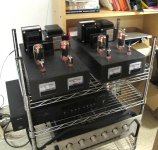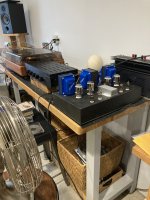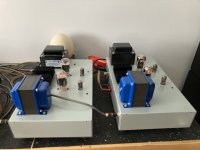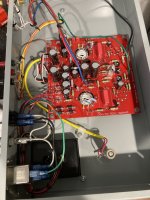I recently built a Nelson Pass Firstwatt amp and am on the home stretch with a more in depth project from Rod Elliot. I also built a few kit preamps that have worked just fine.
I also just bought the boards for the monoblock amp discussed here. I filled most of the BOM last night and ordered the cases.
I want to ask for some advice on how to get a better foundational understanding of what I'm doing with tube amps. So far I'm really just painting by numbers. The discussions here, I can tell, would be great with a better fundamental understanding. Learning on your own is great, but you can end up going along for quite a while with some major misconceptions. Some of the terminology, while I recognize it, is lost on me. Are there any books that someone can recommend that start from the beginning. I know this can be a tough question because many of you probably don't realize how much you actually know. Having spent, in many cases, a lifetime in electronics it probably is second nature. For instance the 6HJ5 tubes seem a little scarce for my monoblock build. I see substitutions mentioned, but I have no idea how to judge candidates for a substitutions or how I'd re-pin the wiring.
Hopefully my request is clear. Anything you could do to point me in a direction would be appreciated.
Thank you
John
I also just bought the boards for the monoblock amp discussed here. I filled most of the BOM last night and ordered the cases.
I want to ask for some advice on how to get a better foundational understanding of what I'm doing with tube amps. So far I'm really just painting by numbers. The discussions here, I can tell, would be great with a better fundamental understanding. Learning on your own is great, but you can end up going along for quite a while with some major misconceptions. Some of the terminology, while I recognize it, is lost on me. Are there any books that someone can recommend that start from the beginning. I know this can be a tough question because many of you probably don't realize how much you actually know. Having spent, in many cases, a lifetime in electronics it probably is second nature. For instance the 6HJ5 tubes seem a little scarce for my monoblock build. I see substitutions mentioned, but I have no idea how to judge candidates for a substitutions or how I'd re-pin the wiring.
Hopefully my request is clear. Anything you could do to point me in a direction would be appreciated.
Thank you
John
iplayforme,
I'm very much a novice but these helped me a little bit:
The "RCA Tube Receiving Manual" has a section on tube theory toward the beginning:
http://www.tubebooks.org/tubedata/rc30.pdf
Uncle Doug's youtube channel also has a good basic explanation on how tube amps work. Parts 1 and 2:
I'm very much a novice but these helped me a little bit:
The "RCA Tube Receiving Manual" has a section on tube theory toward the beginning:
http://www.tubebooks.org/tubedata/rc30.pdf
Uncle Doug's youtube channel also has a good basic explanation on how tube amps work. Parts 1 and 2:
For instance the 6HJ5 tubes seem a little scarce for my monoblock build. I see substitutions mentioned, but I have no idea how to judge candidates for a substitutions or how I'd re-pin the wiring.
When I built my amps, vacuumtubes.net had the 6HJ5 at reasonable prices. Don't support the guy on eBay that's trying to get $80 a pair for them.
Yes, I saw that by now and it certainly seems crazy. This is the price that's paid for something becoming trendy. He's probably sold more than a few pairs.Don't support the guy on eBay that's trying to get $80 a pair for them
I got the tubes at "Vacuum Tubes division of Radio Electric Supply" and was happy with the price and service.https://vacuumtubes.net/
I've seen those videos and they are a great intro. I just received and have been looking through "A beginners guide to tube audio design" by Bruce Rozenblit. Excellent so far. Technical enough but not way over my head. He's starting at the beginning and building.iplayforme,
I'm very much a novice but these helped me a little bit:
The "RCA Tube Receiving Manual" has a section on tube theory toward the beginning:
http://www.tubebooks.org/tubedata/rc30.pdf
Uncle Doug's youtube channel also has a good basic explanation on how tube amps work. Parts 1 and 2:
For those who have built the original, not "monoblock" 50W Engineer's Amplifier -- i.e. both circuits and ps on one board -- somehow I blew the HV trace one one channel. Until the WTF moment, I have no idea why this happened, but the trace was open.
The fix was to simply bridge the trace with another wire.
The Engineer's Amp on my build does a bit better than the illustrations in Pete's writeup, but the 50W monoblock version pair does better still.
The fix was to simply bridge the trace with another wire.
The Engineer's Amp on my build does a bit better than the illustrations in Pete's writeup, but the 50W monoblock version pair does better still.
Sorry if this is a dumb question, but the pinout on the output tubes has 3*2, 4*2, and 5*2 on them. I have not seen this syntax before and was curious about it before wiring up my sockets.
If you look at the 6HJ5 data sheet https://frank.pocnet.net/sheets/049/6/6HJ5.pdf, you'll see that there are 2 connection points for G1, G2, and G3. That's the only reason I can think of for that notation.
You must be using the PCB's without the direct mount sockets?
jeff
You must be using the PCB's without the direct mount sockets?
jeff
You guessed right, I have the version with holes where the compactron sockets were originally. They have two grid holes, marked g1 and g2, plus plate, cathode, heaters locations.
Well from my guessing, it appears that it's just indicating two spots for that pin. A jumper must also be run from pin 2 to pin 4.
I could be totally wrong though.
I could be totally wrong though.
Yes, you must tie G3 to the cathode.A jumper must also be run from pin 2 to pin 4.
jeff
Well, it’s been a while since I posted. I did build the engineers amplifier a while back got the board from George at Hamvention.
Anyhow, started on the 50 W engineers amplifier. Pretty much following Pete’s build. I am going to use a ham and chassis of my choosing so I can space things out a little bit.
Most of my questions answered was the output stage wiring with all the asterisks.
It made sense the cat food grid three have to be attached to each other. Different tubes are gonna be different for me. I’m going with the recommended.
The main difference is I’m going to move the 5K resistor in the power supply up to the top side of the chassis again a wirewound variety just to dissipate the heat. Mosfets of course will be heat sinked, but they’ll be the only source of heat. Other than that, they’ll be built on a 10 x 17 x 3 chassis. I am going to use Edcor output transformers. And I’ll be building more of a horizontal layout. I’ll put transformer heat sink, power transformer circuit board in the front and center.
The engineers amplifier turned out great. I love it. Some nice power just very easy to live with. That’s why I decided to build the 50 W version.
Anyhow, started on the 50 W engineers amplifier. Pretty much following Pete’s build. I am going to use a ham and chassis of my choosing so I can space things out a little bit.
Most of my questions answered was the output stage wiring with all the asterisks.
It made sense the cat food grid three have to be attached to each other. Different tubes are gonna be different for me. I’m going with the recommended.
The main difference is I’m going to move the 5K resistor in the power supply up to the top side of the chassis again a wirewound variety just to dissipate the heat. Mosfets of course will be heat sinked, but they’ll be the only source of heat. Other than that, they’ll be built on a 10 x 17 x 3 chassis. I am going to use Edcor output transformers. And I’ll be building more of a horizontal layout. I’ll put transformer heat sink, power transformer circuit board in the front and center.
The engineers amplifier turned out great. I love it. Some nice power just very easy to live with. That’s why I decided to build the 50 W version.
Attachments
50 watt mono blocks done.
I do notice the power tubes seem to come in two camps for the same perimeters some tend to draw heavy current others lighter so it’s one or the other for the most part.
Another thing I noticed Hammond power transformers the lamination stacks on one is .25 inches thicker Qc issue there. Both however, are dead quiet. So far no issues whatsoever.
I do have to tidy up the wiring and button up everything. The 5k resistor has been moved and replaced with a stud mount ww, runs totally cool.
B+ 420 screens 143 v
current depending on the tubes .4-.6v
Id tighten that up if i had a pile o tubes.
selecting input tubes i was able to get balance in the low mv range.
Running edcor transformers no issues with standard feedback.
I do notice the power tubes seem to come in two camps for the same perimeters some tend to draw heavy current others lighter so it’s one or the other for the most part.
Another thing I noticed Hammond power transformers the lamination stacks on one is .25 inches thicker Qc issue there. Both however, are dead quiet. So far no issues whatsoever.
I do have to tidy up the wiring and button up everything. The 5k resistor has been moved and replaced with a stud mount ww, runs totally cool.
B+ 420 screens 143 v
current depending on the tubes .4-.6v
Id tighten that up if i had a pile o tubes.
selecting input tubes i was able to get balance in the low mv range.
Running edcor transformers no issues with standard feedback.
Attachments
Nice nice nice and tidy build, what about the cases?50 watt mono blocks done.
I do notice the power tubes seem to come in two camps for the same perimeters some tend to draw heavy current others lighter so it’s one or the other for the most part.
Another thing I noticed Hammond power transformers the lamination stacks on one is .25 inches thicker Qc issue there. Both however, are dead quiet. So far no issues whatsoever.
I do have to tidy up the wiring and button up everything. The 5k resistor has been moved and replaced with a stud mount ww, runs totally cool.
B+ 420 screens 143 v
current depending on the tubes .4-.6v
Id tighten that up if i had a pile o tubes.
selecting input tubes i was able to get balance in the low mv range.
Running edcor transformers no issues with standard feedback.
I’m noticing something kind of similar but what stands out is I’ve got some tubes. All perimeters remain the same just pulling more current. so I did some tube matching so I could get the current draw even between the two tubes but then I’ve got some tubes that regardless are going to draw more current, I think I’ll go your route and adjust r13 and r14 till I can get the bias in the range that I want.I had a similar issue, I biased mine to a fraction below 0.400 after 1 hour, then re-biased them a couple of days later. So now on turn on they are about 0.300 and warm up to around 0.500 after about half an hour, mine settle around this level. I also swapped out R13 and R14 for 47k.
I also spent a bit of time matching tubes, that helped as well.
Sorry for the late response, I saw your post and was itching to respond, but I was in the game reserve and the mobile connectivity was very bad.
It kind of seems to me with the final output tubes can say identical perimeters on each tube B+ screen and bias voltage is a pretty wide variation.
It’s kind of interesting there’s the high current draw and the low current draw.
The higher current draw tubes are just outside the range of adjustment for minimum.
- Home
- Vendor's Bazaar
- 50W monoblock "Engineers Amp"






